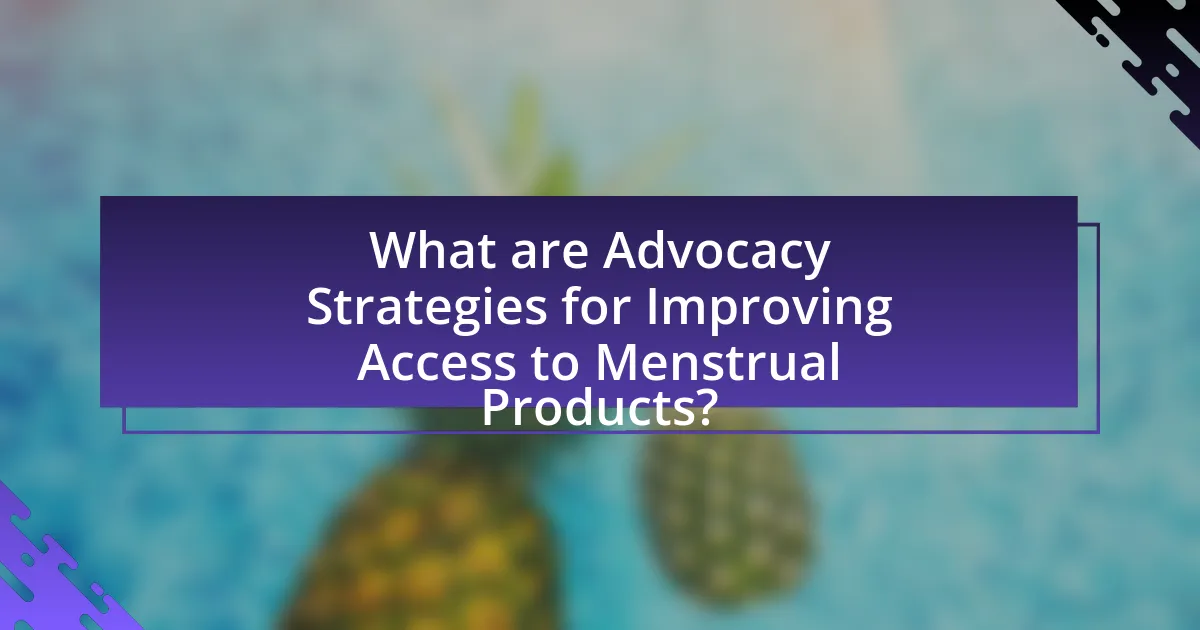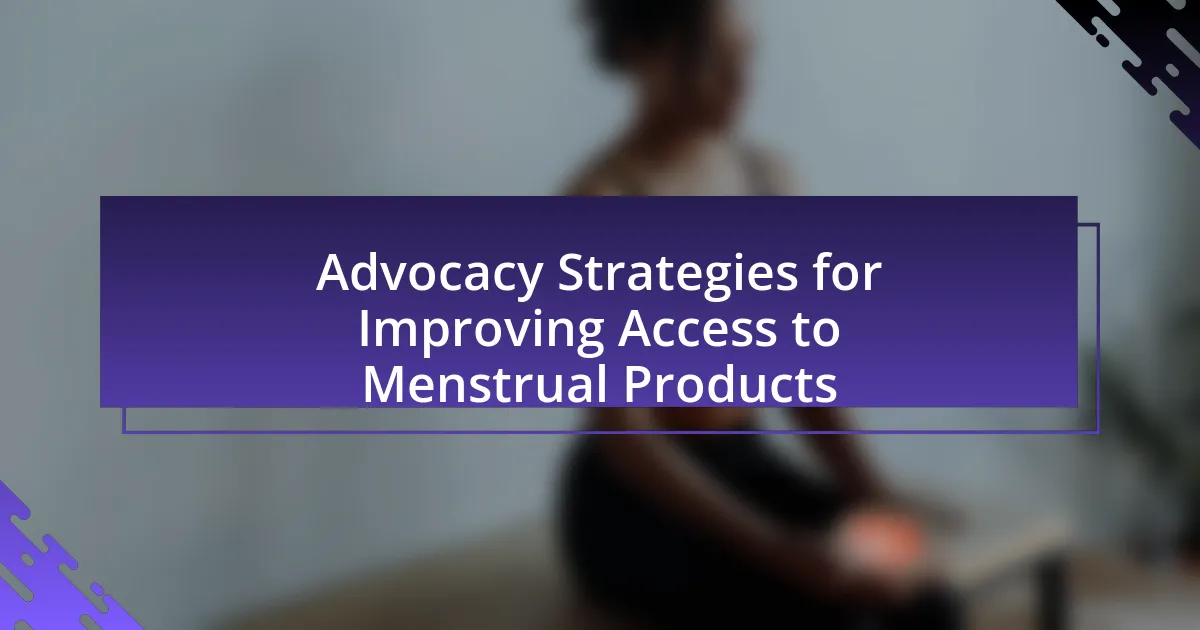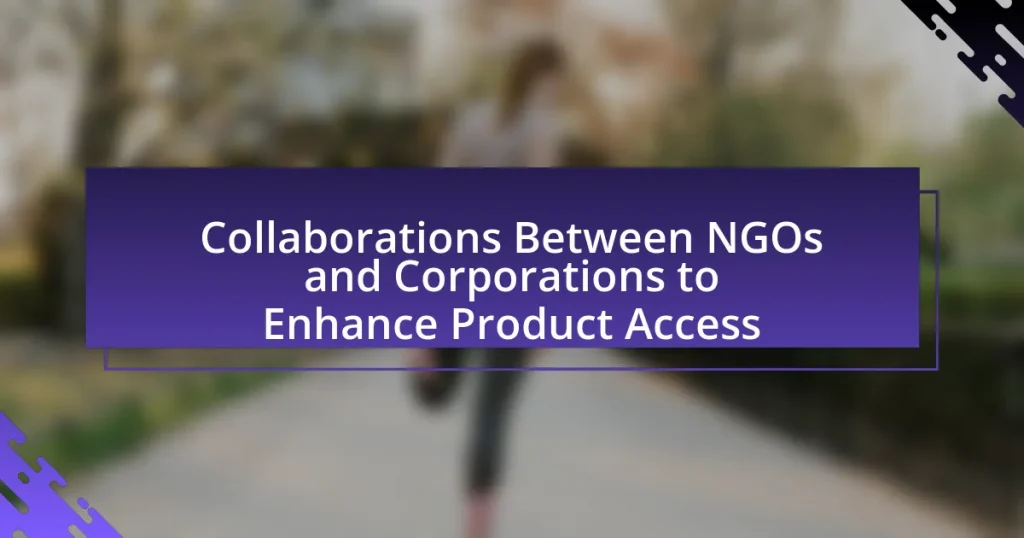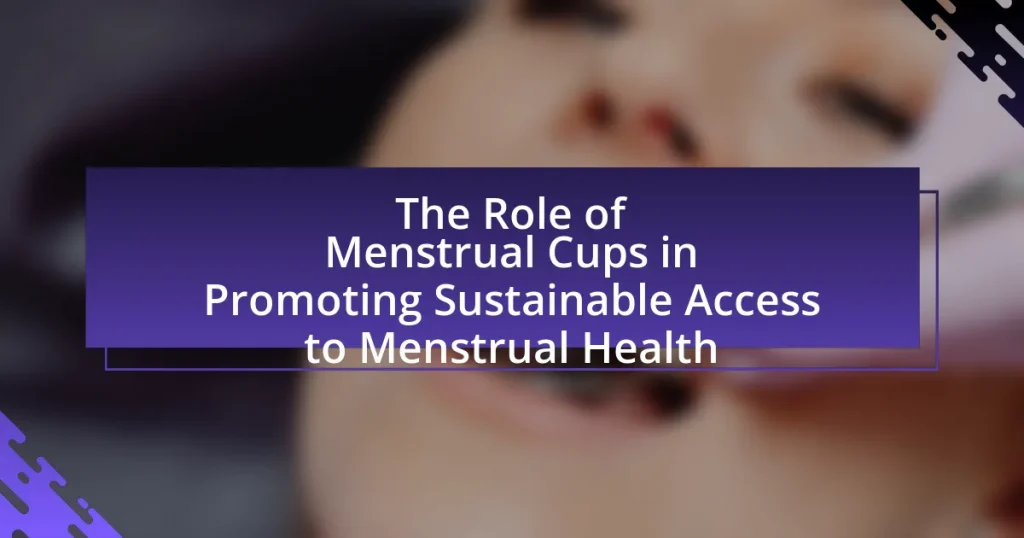The article focuses on advocacy strategies aimed at improving access to menstrual products, highlighting the importance of policy reform, community education, and partnerships with organizations. It discusses the public health implications of inadequate access, including health risks, educational disruptions, and economic consequences. Key components of effective advocacy are outlined, such as clear objectives, targeted messaging, and coalition building, while also addressing challenges like stigma and funding barriers. The article emphasizes the role of data and research in supporting advocacy efforts and showcases successful case studies that demonstrate effective strategies for enhancing menstrual product accessibility.

What are Advocacy Strategies for Improving Access to Menstrual Products?
Advocacy strategies for improving access to menstrual products include policy reform, community education, and partnerships with organizations. Policy reform involves lobbying for legislation that mandates the provision of menstrual products in schools, shelters, and public facilities, which has been shown to increase accessibility and reduce stigma. Community education initiatives aim to raise awareness about menstrual health and hygiene, helping to destigmatize menstruation and inform individuals about available resources. Collaborating with non-profits and health organizations can amplify efforts, as evidenced by programs that have successfully distributed menstrual products to underserved populations, demonstrating the effectiveness of collective action in addressing this public health issue.
Why is access to menstrual products important for public health?
Access to menstrual products is crucial for public health because it directly impacts the hygiene, dignity, and overall well-being of menstruators. When individuals lack access to these essential products, they may resort to using unsafe alternatives, which can lead to health complications such as infections and reproductive health issues. According to a study published in the journal “BMC Women’s Health,” 70% of menstruators in low-income areas reported using improvised materials due to cost barriers, highlighting the urgent need for accessible menstrual products to prevent health risks. Furthermore, inadequate access can lead to absenteeism in schools and workplaces, affecting education and economic productivity, thereby amplifying public health challenges.
How does lack of access to menstrual products affect individuals and communities?
Lack of access to menstrual products significantly impacts individuals and communities by leading to health issues, educational disruptions, and social stigma. Individuals without these products often experience increased risk of infections and other health complications due to inadequate menstrual hygiene management. For instance, a study by the Water Supply and Sanitation Collaborative Council found that 1 in 10 girls in Africa misses school during menstruation, which contributes to higher dropout rates and limits future opportunities. Communities also suffer as a result; when menstruators are unable to participate fully in education or work, it hinders economic development and perpetuates cycles of poverty. Furthermore, the stigma surrounding menstruation can lead to isolation and mental health challenges, affecting overall community well-being.
What are the social and economic implications of inadequate menstrual product access?
Inadequate access to menstrual products leads to significant social and economic implications, including increased absenteeism in education and the workforce. Studies indicate that girls may miss up to 20% of school days due to menstruation-related issues, which can hinder their academic performance and future opportunities. Economically, women who lack access to menstrual products may face job loss or reduced income, as they are unable to attend work during their menstrual cycles. The World Bank estimates that the economic cost of lost productivity due to inadequate menstrual hygiene management can reach billions annually. Furthermore, the stigma surrounding menstruation can exacerbate social inequalities, leading to feelings of shame and isolation among those affected.
What are the key components of effective advocacy strategies?
The key components of effective advocacy strategies include clear objectives, targeted messaging, coalition building, and strategic communication. Clear objectives define the specific goals of the advocacy effort, such as increasing access to menstrual products. Targeted messaging ensures that the communication resonates with the intended audience, emphasizing the importance of menstrual health and hygiene. Coalition building involves forming partnerships with stakeholders, including NGOs, community groups, and policymakers, to amplify the advocacy efforts. Strategic communication utilizes various channels, such as social media, public campaigns, and direct engagement, to effectively reach and influence decision-makers. These components are essential for creating impactful advocacy that can lead to policy changes and improved access to menstrual products.
How can awareness campaigns influence public perception and policy?
Awareness campaigns can significantly influence public perception and policy by educating the public on issues related to menstrual health and advocating for necessary changes. These campaigns raise visibility around the challenges faced by individuals in accessing menstrual products, thereby shifting societal attitudes and fostering empathy. For instance, campaigns like “Period Poverty” have successfully highlighted the lack of access to menstrual products, leading to policy changes in various regions, such as the implementation of free menstrual products in schools and public facilities. Research indicates that increased awareness correlates with legislative action; for example, a study by the University of Edinburgh found that public campaigns led to a 30% increase in support for policies addressing menstrual product accessibility. This demonstrates that awareness campaigns not only inform but also mobilize public opinion, ultimately influencing policymakers to enact supportive legislation.
What role do partnerships play in advocacy for menstrual product access?
Partnerships play a crucial role in advocacy for menstrual product access by combining resources, expertise, and networks to amplify efforts. Collaborative initiatives between non-profits, governmental organizations, and private sector companies enhance outreach and awareness, leading to increased availability of menstrual products. For instance, partnerships can facilitate distribution channels in underserved communities, ensuring that products reach those in need. Evidence shows that organizations like Days for Girls and local health departments have successfully partnered to provide menstrual health education and product distribution, significantly improving access in various regions.
What challenges do advocates face in improving access to menstrual products?
Advocates face significant challenges in improving access to menstrual products, primarily due to stigma, lack of funding, and policy barriers. Stigma surrounding menstruation often leads to silence and shame, hindering open discussions and awareness campaigns that could promote access. Additionally, inadequate funding for menstrual health initiatives limits the distribution of products, particularly in low-income communities. Policy barriers, such as the absence of legislation mandating free access to menstrual products in schools and public facilities, further exacerbate the issue. For instance, a study by the Menstrual Health Hub highlights that 1 in 5 girls in the U.S. have missed school due to lack of access to menstrual products, underscoring the urgent need for systemic change.
How do cultural stigmas impact advocacy efforts?
Cultural stigmas significantly hinder advocacy efforts by creating barriers to open dialogue and acceptance regarding menstrual health. These stigmas often lead to misinformation and shame surrounding menstruation, which can discourage individuals from seeking help or participating in advocacy initiatives. For instance, a study published in the journal “BMC Women’s Health” found that cultural taboos surrounding menstruation can result in a lack of awareness and education about menstrual hygiene management, ultimately affecting policy changes and resource allocation. Consequently, when cultural stigmas persist, they undermine the effectiveness of advocacy campaigns aimed at improving access to menstrual products, as they prevent communities from engaging in necessary discussions and actions.
What legal and policy barriers exist in different regions?
Legal and policy barriers to access menstrual products vary significantly across regions. In many low-income countries, lack of government policies supporting menstrual health leads to inadequate distribution of products, as seen in countries like Kenya, where the absence of a national policy results in limited access for women and girls. In contrast, in some developed regions, taxation on menstrual products as luxury items, such as in parts of the United States, creates financial barriers that hinder access. Furthermore, cultural stigmas surrounding menstruation can lead to restrictive policies that limit education and awareness initiatives, as observed in various South Asian countries where menstruation is often considered taboo. These barriers collectively impede efforts to improve access to menstrual products and highlight the need for targeted advocacy strategies.
How can data and research support advocacy efforts?
Data and research can significantly enhance advocacy efforts by providing evidence-based insights that inform strategies and policies. For instance, studies have shown that lack of access to menstrual products can lead to absenteeism in schools, with one report indicating that 1 in 5 girls in the U.S. have missed school due to menstruation. This data can be leveraged to advocate for policy changes that ensure free access to menstrual products in educational institutions. Furthermore, research can identify the demographics most affected by product scarcity, allowing advocates to tailor their messaging and outreach effectively. By utilizing concrete statistics and findings, advocacy campaigns can gain credibility, mobilize support, and influence decision-makers to implement necessary changes.
What types of data are most effective in highlighting the need for access to menstrual products?
Quantitative data, such as statistics on period poverty and surveys on menstrual product accessibility, are most effective in highlighting the need for access to menstrual products. For instance, a study by the American Medical Association found that 1 in 5 teens in the U.S. have missed school due to a lack of menstrual products, illustrating the significant impact of inadequate access. Additionally, qualitative data, including personal testimonies and focus group discussions, can provide insight into the lived experiences of individuals affected by menstrual product scarcity, further emphasizing the urgency for improved access.
How can research findings be utilized to influence policymakers?
Research findings can influence policymakers by providing evidence-based data that highlights the necessity for legislative changes regarding access to menstrual products. For instance, studies demonstrating the economic burden of inadequate menstrual hygiene management can compel policymakers to allocate resources for subsidizing menstrual products. A report by the World Bank in 2020 indicated that lack of access to menstrual products can lead to school absenteeism, affecting girls’ education and future opportunities. By presenting such data, advocates can effectively argue for policies that ensure affordable and accessible menstrual products, thereby driving legislative action.
What successful case studies exist in menstrual product advocacy?
Successful case studies in menstrual product advocacy include the “Menstrual Hygiene Management in Schools” initiative in Kenya, which increased access to sanitary products for over 1 million girls, leading to a 30% increase in school attendance among menstruating students. Another notable case is the “Period Poverty” campaign in the UK, which resulted in the government committing £2 million to provide free menstrual products in schools, addressing the needs of low-income students. Additionally, the “Dignity Drive” in India successfully distributed over 1 million menstrual kits to underserved communities, significantly raising awareness and reducing stigma around menstruation. These case studies demonstrate effective strategies in improving access to menstrual products and enhancing menstrual health education.
What strategies were employed in these successful case studies?
Successful case studies in improving access to menstrual products employed strategies such as community engagement, policy advocacy, and educational campaigns. Community engagement involved collaborating with local organizations to identify needs and mobilize resources effectively. Policy advocacy focused on influencing legislation to ensure menstrual products are included in public health initiatives, as seen in countries that have implemented tax exemptions on these products. Educational campaigns raised awareness about menstrual health and hygiene, leading to increased public support and reduced stigma, which is evidenced by surveys showing improved attitudes towards menstruation in communities that participated in such initiatives.
What lessons can be learned from these examples for future advocacy?
Future advocacy for improving access to menstrual products can learn the importance of community engagement and collaboration. Engaging local communities fosters trust and ensures that advocacy efforts are tailored to specific needs, as demonstrated by successful campaigns that involved grassroots organizations. Additionally, leveraging data to highlight the impact of menstrual product access on health and education can strengthen arguments; for instance, studies show that lack of access can lead to increased absenteeism among menstruating students. Finally, utilizing social media platforms effectively can amplify messages and mobilize support, as seen in campaigns that gained traction through viral sharing and public awareness initiatives.
How can individuals contribute to advocacy for menstrual product access?
Individuals can contribute to advocacy for menstrual product access by raising awareness, engaging in community education, and supporting policy changes. By sharing information about the importance of menstrual health and the barriers many face in accessing products, individuals can help destigmatize menstruation and promote understanding. Engaging in community education initiatives, such as workshops or discussions, can empower others and create a supportive environment. Additionally, advocating for policy changes, such as lobbying for free menstrual products in schools and public facilities, can lead to systemic improvements in access. Research indicates that 1 in 5 girls in the U.S. have missed school due to a lack of menstrual products, highlighting the urgent need for advocacy efforts to address this issue.
What grassroots actions can individuals take to support this cause?
Individuals can support the cause of improving access to menstrual products by organizing local donation drives to collect menstrual supplies for those in need. These drives can directly address the issue of period poverty, which affects one in four women in the U.S. who struggle to afford menstrual products, according to a study by the American Medical Association. Additionally, individuals can advocate for policy changes by contacting local representatives to promote legislation that mandates free menstrual products in schools and public facilities, as seen in recent laws passed in states like California and New York. Engaging in community education initiatives to raise awareness about menstrual health and hygiene can also empower others and reduce stigma, further supporting the cause.
How can social media be leveraged for advocacy efforts?
Social media can be leveraged for advocacy efforts by creating awareness, mobilizing support, and facilitating communication among stakeholders. Advocacy groups can utilize platforms like Twitter, Facebook, and Instagram to share impactful stories, statistics, and educational content about menstrual health, thereby reaching a wider audience. For instance, campaigns such as #PeriodPoverty have successfully raised awareness about the lack of access to menstrual products, leading to increased public discourse and policy changes. Additionally, social media allows for real-time engagement, enabling advocates to organize events, petitions, and fundraising efforts efficiently, which can significantly amplify their impact.
What are best practices for effective advocacy in this area?
Effective advocacy for improving access to menstrual products involves several best practices. First, building strong coalitions with stakeholders, including NGOs, community leaders, and policymakers, enhances the advocacy effort by pooling resources and expertise. Research indicates that collaborative advocacy can increase the likelihood of policy change, as seen in successful campaigns like the Menstrual Health Hub, which united various organizations to address menstrual equity.
Second, utilizing data-driven approaches to highlight the need for access to menstrual products is crucial. For instance, studies show that 1 in 4 girls in the U.S. have missed school due to a lack of menstrual products, underscoring the urgency of the issue. Presenting such statistics to policymakers can effectively convey the importance of the cause.
Third, engaging in public awareness campaigns that educate communities about menstrual health and hygiene can shift societal perceptions and reduce stigma. Campaigns like “Period Poverty” have successfully raised awareness and mobilized support for policy changes in various regions.
Lastly, advocating for policy changes at local, state, and national levels, such as tax exemptions on menstrual products and funding for free product distribution in schools, can lead to systemic improvements. Legislative efforts in states like California, which passed a law to provide free menstrual products in public schools, serve as a model for effective advocacy.
How can advocates measure the impact of their strategies?
Advocates can measure the impact of their strategies by utilizing quantitative and qualitative metrics such as surveys, focus groups, and data analysis. For instance, surveys can assess changes in public awareness or attitudes towards menstrual product access before and after advocacy efforts, while focus groups can provide in-depth insights into the experiences of individuals affected by these issues. Additionally, tracking policy changes or increases in product availability in targeted areas serves as concrete evidence of advocacy effectiveness. Research from the “Journal of Public Health” indicates that organizations employing mixed-methods evaluations see a 30% increase in understanding their impact compared to those using single-method approaches.
What ongoing efforts are necessary to sustain advocacy for menstrual product access?
Ongoing efforts necessary to sustain advocacy for menstrual product access include continuous public awareness campaigns, policy advocacy, and collaboration with stakeholders. Public awareness campaigns educate communities about menstrual health and the importance of access to products, which can reduce stigma and promote understanding. Policy advocacy involves lobbying for legislation that mandates free or subsidized menstrual products in schools, shelters, and public facilities, as seen in various regions where such laws have been enacted. Collaboration with stakeholders, including non-profits, government agencies, and businesses, ensures a multifaceted approach to addressing barriers and expanding access. For instance, organizations like Period.org have successfully mobilized resources and partnerships to distribute menstrual products to underserved populations, demonstrating the effectiveness of these combined efforts.



